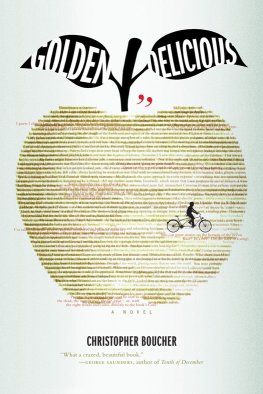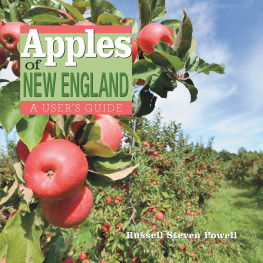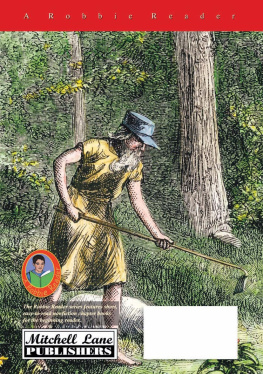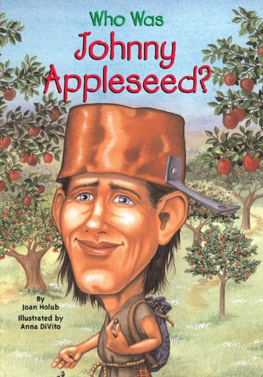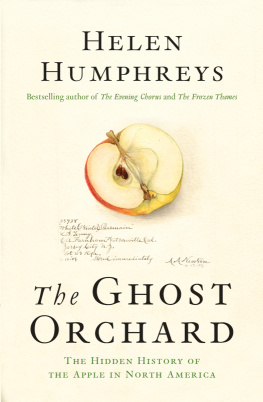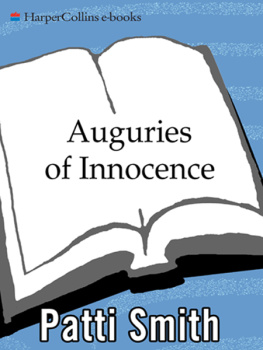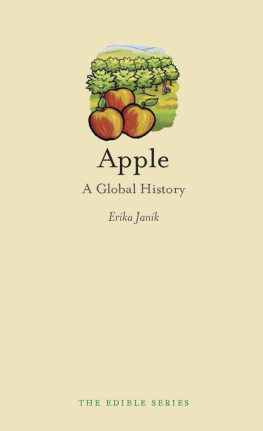THE JOHNS HOPKINS UNIVERSITY PRESS
DIRECTORS CIRCLE BOOK FOR 2012
The Johns Hopkins University Press gratefully acknowledges members of the 2012 Directors Circle for supporting the publication of works such as Johnny Appleseed and the American Orchard.
Anonymous
Gregory S. Aldrete
Dominic and Helen Averza
Alfred and Muriel Berkeley
John and Bonnie Boland
Darlene Bookoff
Jack Goellner and Barbara Lamb
Charles and Elizabeth Hughes
John T. Irwin
John and Kathleen Keane
Mary L. Kelly
X. J. and Dorothy Kennedy
Anders Richter
Guenter B. Risse
Winston and Marilyn Tabb
JOHNNY APPLESEED AND THE AMERICAN ORCHARD
A Cultural History
WILLIAM KERRIGAN

2012 The Johns Hopkins University Press
All rights reserved. Published 2012
Printed in the United States of America on acid-free paper
2 4 6 8 9 7 5 3 1
The Johns Hopkins University Press
2715 North Charles Street
Baltimore, Maryland 21218-4363
www.press.jhu.edu
Library of Congress Cataloging-in-Publication Data
Kerrigan, William, 1963
Johnny Appleseed and the American orchard : a cultural
history / William Kerrigan.
p. cm.
Includes bibliographical references and index.
ISBN 978-1-4214-0728-9 (hdbk. : alk. paper) ISBN 978-1-4214-0729-6
(pbk. : alk. paper) ISBN 978-1-4214-0796-8 (electronic)
ISBN 1-4214-0728-0 (hdbk. : alk. paper) ISBN 1-4214-0729-9
(pbk. : alk. paper) ISBN 1-4214-0796-5 (electronic)
1. Appleseed, Johnny, 17741845. 2. Apple growersUnited States
Biography. 3. Frontier and pioneer lifeMiddle WestHistory. I. Title.
SB63.C46K47 2013
634.11092dc23
[B] 2012012916
A catalog record for this book is available from the British Library.
Special discounts are available for bulk purchases of this book. For more information,
please contact Special Sales at 410-516-6936 or specialsales@press.jhu.edu.
The Johns Hopkins University Press uses environmentally friendly book
materials, including recycled text paper that is composed of at least 30
percent post-consumer waste, whenever possible.
Maps and Figures
MAPS
FIGURES
Preface
In the spring of 1970 my first-grade class at Lewis Sands Elementary in Chagrin Falls, Ohio, began preparing to put on a pageant on the American story, to be performed for a cafeteria full of parents eagerly wielding their Kodak Instamatic cameras. Most details of that pageant are lost to me today. But I do have some memory of the first day of preparation for the event, when it was time to assign parts. When the teacher asked the boys in the classroom who would like to play the part of Johnny Appleseed, I and one or two other boys eagerly raised our hands. The part went to a small boy named Hal, the class clown, who had a flair for dramatic gestures, and he proved worthy of the part. When the time came for Hal to stride across the stage, he flung his seeds with the appropriate panache.
There were plenty of other parts in a drama about the nations founding to delight a classroom full of six-year-old boys. There were the coonskin-cap-wearing frontiersmen, who got to shoulder rifles, and the wild and savage Indians, with feather headbands and rubber tomahawks, and there were many enthusiastic volunteers for these roles. The least desirable role, from my perspective, was that of the pioneer husband, riding on his Conestoga wagon beside a sunbonnet-clad pioneer wife. It was my fate to take the reins of a makeshift wagon, improvised with a couple of cafeteria tables and a great deal of cardboard and construction paper. I envied Hal for his Johnny Appleseed part, and I dreaded the humiliation that accompanied my rolesitting beside a girl and pretending we were married, and dealing with the barbs and teasing of the other boys. It was decades before I understood that the role I and my wife played were two of the most important in the whole drama, for the story of Americas birth as told to generations of schoolkids is at heart the story of the domestication of a continent, and there was no greater symbol of the successful domestication of North America than the pioneer family. Johnny Appleseed was a colporteur of that process.
My interest in the legendary Johnny Appleseed lay dormant for more than a quarter century but was reawakened when a job at a small liberal arts college brought me back to Ohio. I began gathering materials for this book not long after I arrived at Muskingum College (now University) in 1997. I began bringing a bicycle and a kayak along on my research trips so that I could explore more closely the landscapes John Chapman wandered. That these explorations could be considered part of my job reminded me of how privileged I was to hold the position of liberal arts college professor, where I had the freedom to engage in such unconventional but intellectually rewarding research strategies.
Early on in my research I was blessed with additional support through the Muskingum Summer Fellowship Program, which provides opportunities for undergraduate students to work with faculty on real research projects. Erin Stevic, my first Muskingum Summer Fellow, did an extraordinary job organizing the mountains of photocopies and scraps of notes I brought back from these trips into a framework that was still intact when I completed the manuscript more than a decade later, and she also took exploratory trips to archives I had not yet visited, returning with reports about what these places held, which proved invaluable to me when I visited those locations later. As I make the last revisions to this project it seems poetically perfect that I am co-teaching a course with my former student, now a colleague and dear friend.
The financial support of several external organizations were also critical in the completion of this book. Urbana Universitys Swedenborgian-Scholar-in-Residence program enabled me to spend time in the largest collection of Swedenborgian writings in the United States and to mine the archives of the Johnny Appleseed Society that resides on that campus. A weeklong residency at the Filson Historical Society yielded valuable material on the history of orchard agriculture in the Ohio Valley. The opportunity to participate in the SHEAR-Mellon seminar on undergraduate research with my student Ryan Worbs provided me with the time to explore the William Irvine papers in the Pennsylvania Historical Society archives, a collection that greatly enhanced of this work. A National Endowment for the Humanities Summer Writing Fellowship in 2010 provided the critical push needed to turn a few rough chapters into a completed manuscript.
I am grateful to Muskingum University president Anne Steele and the board of trustees for their continued commitment to supporting faculty research. Early financial support for this project came from the Charlotte Green Foundation and Muskingum University, which enabled me to spend time during spring and summer breaks on driving trips to local historical societies in many of the communities, from Massachusetts to Indiana, that claimed a connection to John Chapman. Two semester-long sabbaticals were also devoted to research and writing this book. In the final years of this project, funds made available from the Arthur and Eloise Cole Distinguished Chair in American History covered the expenses of additional trips to distant archives and for many of the books still stacked around the edges of my computer monitor.
I called upon, and received, generous help from countless professionals and volunteers connected to libraries, archives, and historical societies I visited. All earned my deep appreciation. A few deserve special mention: Joe Besecker, Steven Cooley, and Julie McDaniel at Urbana University; Jan Longone at the Clements Library in Ann Arbor; Linda Showalter at the Marietta College Special Collections and Archives; and, especially, Sheila Ellenberger and the amazing staff of the Muskingum University library, who helped me track down some impossibly obscure old books, tracts, and pamphlets.
Next page

